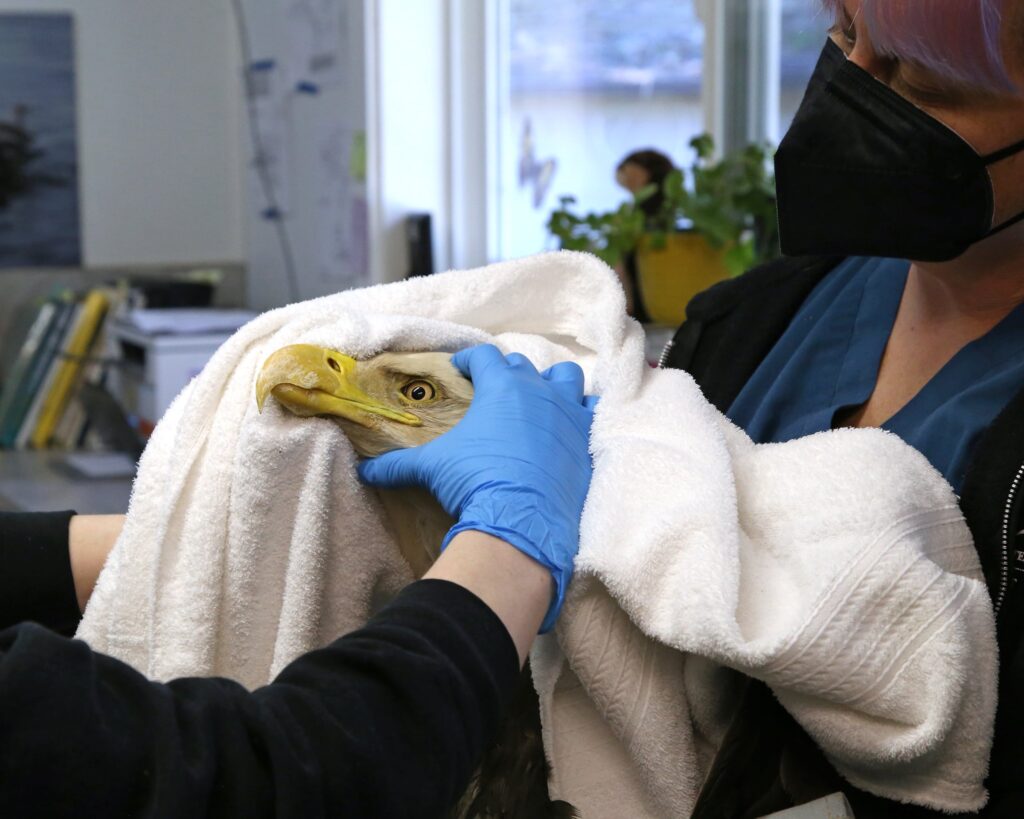The Wildlife Center of the North Coast in Astoria has admitted three bald eagles in recent weeks, an unusual spike that highlights an ongoing but often overlooked threat to raptors in Oregon: lead poisoning.
While the center treats bald eagles every year, staff say receiving three in such a short time is uncommon. Two of the three birds tested positive for lead exposure upon arrival.
And last March, a Prineville Fish and Wildlife trooper responded to reports of
an injured eagle
on a Powell Butte property. An assessment found that the juvenile bald eagle was also suffering from lead poisoning.
Bald eagles may be America’s mascot, but they’re not the majestic predators people like to imagine. They’re opportunistic scavengers that prefer carrion over fresh kills. And a gut pile left behind by a hunter? That’s the perfect meal: warm, easy to find and already opened up. But when that gut pile contains bullet fragments made of lead, the consequences can be deadly. Even microscopic pieces are enough to poison an eagle, causing neurological damage or death.
Bald eagle recovery in Oregon and southern Washington
Spring bear season
was open in Northwest Oregon during the timeframe the Astoria wildlife center reported the bald eagle admissions, so hunting and gut piles left behind are a likely cause of the poisoning.
A 2022 study published in
Science
and backed by the U.S. Geological Survey
found that nearly half of all bald and golden eagles across North America show signs of chronic lead poisoning. About one-third of the birds experienced acute lead exposure, particularly during hunting season.
Researchers analyzed samples from 1,210 eagles—both alive and dead — across 38 states over eight years, revealing that scavenging on carcasses and gut piles left behind by hunters using lead ammunition is the primary cause. Population models estimate that lead poisoning is reducing bald eagle population growth by almost 4% per year and golden eagle growth by almost 1%.
In addition to gut piles, eagles may ingest lead from spent shotgun pellets, lost fishing tackle like sinkers and jigs, lead-contaminated fish, unretrieved waterfowl, or in rare cases, exposure at mining sites and landfills. But gut piles—full of soft tissue and easy to spot—offer eagles an irresistible and highly dangerous source of lead exposure during hunting season.
Bald eagle populations on the rise
Bald eagle populations have rebounded across the United States following decades of conservation work, but toxic lead fragments continue to threaten the species. Even small amounts of lead can cause neurological issues, organ damage and death.
Bald eagle breeding pairs in the U.S.
Estimated bald eagle breeding pairs across the U.S. from 1962 to 2007, based on U.S. Fish and Wildlife Service surveys. The most recent comprehensive survey in 2018 found 71,467 breeding pairs nationwide — a dramatic rise — but used a new methodology, including aerial imagery and remote sensing, making it incompatible with earlier counts shown in this chart.
The Wildlife Center is asking for public support to help cover the cost of treatment and care for the eagles including “chelation therapy,” a medical process used to remove lead from a bird’s system.
People interested in learning more can also check out these organizations working to stop lead poisoning in raptors or to treat poisoned ones.
Oregon and southwest Washington lead-free wildlife efforts:
-
Wildlife Center of the North Coast
(Astoria, OR) Rehabilitates lead-poisoned eagles and other raptors; accepts donations, meat, and falconry gear to aid recovery.
-
Chintimini Wildlife Center
(Corvallis, OR) Treats raptors suffering from lead exposure and educates the public about non-lead hunting alternatives.
-
Blue Mountain Wildlife
(Pendleton, OR) Covers eastern Oregon and SE Washington; frequently cares for eagles suffering from lead toxicity.
-
The Raptor Center at Portland Audubon
(Portland, OR) Rehabilitates injured birds of prey and promotes lead-free ammunition outreach.
-
North American Non-Lead Partnership
Oregon Department of Fish and Wildlife is a listed partner. Promotes voluntary use of lead-free ammo among hunters.
By Mark Graves | The Oregonian/OregonLive
Have you heard of other eagle lead poisoning cases in Oregon or Washington?
Email Mark Graves at mgraves@oregonian.com.
Sources:
U.S. Geological Survey and
Science
journal’s 2022 eagle lead study, Washington Department of Fish and Wildlife’s 1980–2007 bald eagle monitoring report, Oregon Department of Fish and Wildlife and U.S. Fish and Wildlife Service population estimates.





More Stories
Several bald eagles have been poisoned by lead, pointing to an overlooked threat
Several bald eagles have been poisoned by lead, pointing to an overlooked threat
Several bald eagles have been poisoned by lead, pointing to an overlooked threat